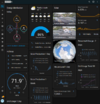Sure, that's easy to add, just did it. Pull the latest version and give it a try, the data will be in the
soe directory. It's also 15min resolution, since that's how Tesla tracks it. To get all the past battery charge data, you'll have to rename or move your existing download directory, since it won't try to download data for days where you already have the
power data. If you only care about data going forward, no changes are needed.
Btw to track Powerwall degradation, it might be more useful to get the full pack energy data from the batteries directly. If you don't want to deal with Gateway APIs, look at the
Netzero for Tesla app (disclaimer: I wrote that).
@offandonagain : One quick return to offer thanks once again. Took me a while to figure out an annoying time zone problem (your script now delivers data in my local time zone instead of UTC), but all good and working now. Going to be SO MUCH easier to not have to do that manual daily download from the app, and doubly nice to have the extra precision (app data rounded to 0.1 kW).
Thought you might value seeing how I use this data (so far). I combine the Tesla gateway data with data separately downloaded from
1. SolarEdge inverter - to check and calibrate the Tesla solar power values (which I presume to be most accurate). Turns out this is quite critical because the Tesla home load is net of other values, and if solar data is off, estimated home load is off (by a larger fraction). In my case, the Tesla gateway is reporting power levels ~5% too high, which when that power is properly allocated to home load can quite significant (on a sunny day). [Data download site provided by SolarEdge.]
2. Utility Smart Meter - similarly used to check any potential discrepancy between Tesla reported grid data and the actual fiscal meter also presumed more accurate. In my case, no statistically significant variance here meriting correction. [Handy public data download site here in Texas.]
3. Span Smart Power Panel Data (limited) - right now Span doesn't have a setup for direct customer data download, but I've gotten limited intervals from their help desk when trouble shooting some early problems. Allowed me to see parasitic load of that system (small, but measurable). Although my key logic in installing the Span was adding backup management flexibility, I do think in time once I get the circuit level data routinely, will enable smarter management of home loads in response to varying power surplus/deficit conditions. Can't do much until they give regular data access.
4. Weatherflow Tempest weather station - For now, just allows me to see and understand the very material impact of weather on power production and consumption. But aspiration is to couple hyper-local weather forecasting in both load and backup management (Tesla's "storm watch" is too primitive and most often too late to do any good). [Similar user-community written routine (in a "Docker" program.]
FWIW, missing for now is smart thermostat data, but hope to be able to find one that can deliver what I want in the future. Conceptually easy to see how with a bit of learning, could actively couple A/C loads to power surplus/deficit status and outlook, after all, air and walls are just a thermal battery.
Below then some example charts of 5 minute (over narrow time window), daily and monthly data. Altogether this helps me evaluate the merits of my system design (which for now I'm quite happy with). In my best month (February here in coastal TX), I was 96% self-powered only still having to buy a little from grid even though I had a net surplus due to minute-by-minute load demand. Worst was 69% self-powered in August during the brutal summer 2023 heat dome over Texas (really visible on daily temp chart!), but even then during a few periods we were 95%+ self-powered because we were gone from the house and just turned up thermostats (to flat 78F).
More than anything, having this data has made it hugely obvious just how important having that local battery storage is to getting value out of the solar. Without that battery, I would have just been selling cheap power to the grid when the sun was shining, and bought back expensive power in the evening (like I did on the first day in below image where battery was full as backup protection due to storm passing during the night before).
More to do even with current data sets on things like battery efficiency (right now ~90% looks right), and especially interested in deep dive on economic value as I now get past my first full year of the system, but it is all only possible with data.
Kind of a shame Tesla (and others) don't make it easier already, but I am grateful that you took the time to share your code to make the critical data download step easier! Thanks again - I am back in business!



